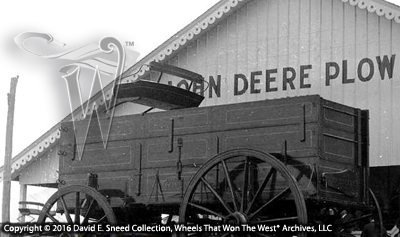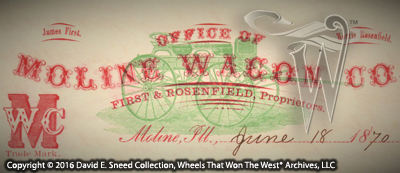It's been over two and a half years since I've reported any new findings on the huge, double-sized wagon unveiled by the Moline Wagon Company in 1904. As many know, the head-turning piece was designed as an unforgettable display for the St. Louis World's Fair that year. Back in 2013 and 14, it was encouraging to discover more previously unknown details about this huge promotional piece. Those particulars can be seen in two different blog posts from January 2014 and February 2014. For decades, collectors and history seekers have scoured the country in search of this famous set of wheels. I've certainly spent my share of time looking for clues as to where this iconic piece of transportation and agricultural history ended up. The trek has taken up countless hours of research and plenty of conversation. Still, it's managed to hang onto a certain amount of intrigue while remaining an elusive beast of burden.
 |
| This 1906 photo from the Lincoln, Nebraska Fairis one of only two surviving images known to have captured the giant Moline wagon at that event. |
Again and again, folks familiar with thestory of this giant ask the same question... "What happened to it?" From our own research and archives, I've repeatedly been fortunate to find significant and largely unknown information. One of the more interesting revelations has been that the wagon was used within multi-state promotional tours by the Moline company and its dealers years after the first showings at the World's Fair. Still, the trail has been cold for some time. The last glimpse we were able to get of the wagon was at a fair in Nebraska during 1906. Since then, nothing. No trade reports. No newspaper clippings. No photos. No other details have come to light. It's as if the wagon just disappeared. But, as I mentioned in my February 12, 2014 blog, details on mysteries like this can sometimes come right out of the blue.
That's just what happened last week whenI was canvassing an April 1909 issue of "The Hub." Positioned just below a short story about the Abbot-Downing Company falling into receivership was an equally brief write-up sharing the whereabouts of the colossal Moline wagon. Finally, after more than 100 years in hiding, the secret of what happened to this magnificent piece of history was being revealed!
As the story points out, five years after first being shown at the St. Louis World's Fair, the wagon was being given a permanent home. The article reiterated that the show-stopping attraction had been publicized extensively in state and national fairs during the previous years. As of the 1909 writing, though, the big wagon was in the process of being placed on top of four, concrete pillars at the east end of Moline Wagon Company's lumber yard. The pillars were nine feet in height, meaning that the entire structure with the wagon would stand at least twenty-five feet tall! It was intended to be the final tribute to the legendary set of wheels (and brand), standing where it would be a continuous topic of conversation to all passers-by.
The enormous concrete platform was a fitting display, visibly reinforcing the power, reputation, and legacy of the historic brand. Nonetheless, after reading this report, it's not hard to imagine what ultimately happened to the huge wagon. After a few years atop the concrete pedestal, the effects of a continual barrage of sun, snow, ice, and raw elements would have surely taken their toll; leaving the wooden titan in a deteriorated condition. Also, knowing that just a year later, John Deere would buy the firm and two years after that change the name from Moline to John Deere; it's easy to understand that the hulking wagon would have ultimately been dismantled and disposed of. It had served a strong purpose for many years but, as the Moline brand disappeared from daily life so was the fate of the equally colossal wagon. Both appear to have vanished at the same time and, even with their once prominent fame, are merely a pale curiosity today.

This graphic from an 1870 company letter is easily among the oldest survivors from the legendary Moline Wagon Company. It's just one of numerous rare artifacts housed in the Wheels That Won The West Archives.
It would be interesting to know if any photos may yet be found of the old promotional icon mounted on its concrete-column throne. Even if none were taken or have survived, I can now finally put this legend to rest. No longer do I expect to come across an actual piece of this three-dimensional superstar. Like so many other notable wheels pointing to another time, this five-ton monster was likely allowed to wither into oblivion.
Used throughout the West as farm, freight, military, emigrant, and chuck wagons, Moline was among the most competitive and revered brands inside America's first transportation industry. By the time John Deere purchased the firm, Moline was building 30,000 wagons per year. It's a rate that translated into 600 completed wagons per week (10 per hour - 100 per day). Even with so many produced, original Moline wagons with respectable amounts of factory paint are still among the rarer finds today.
On another note, it's been a while since I included a SIGN-UP REMINDER but if you'd like to have notifications of these weekly writings sent to you, just click on the LINK IN THE UPPER RIGHT of our website. You'll receive a confirmation and then be alerted when we've made an addition to the site. Please don't hesitate to let us know if we can be of assistance. We appreciate your continued feedback and look forward to sharing even more throughout the year.
Please Note: As with each of our blog writings, all imagery and text is copyrighted with All Rights Reserved. The material may not be broadcast, published, rewritten, or redistributed without prior written permission from David E. Sneed, Wheels That Won The West® Archives, LLC